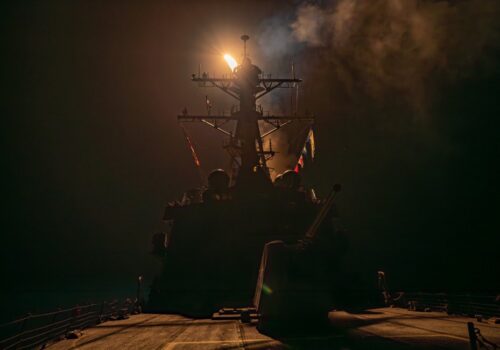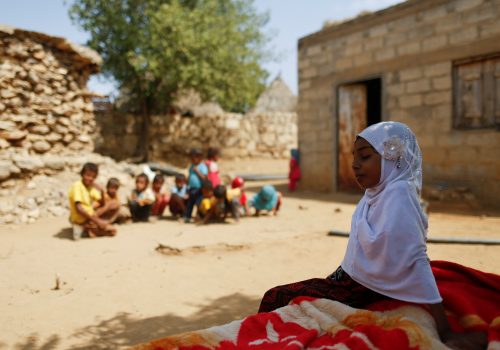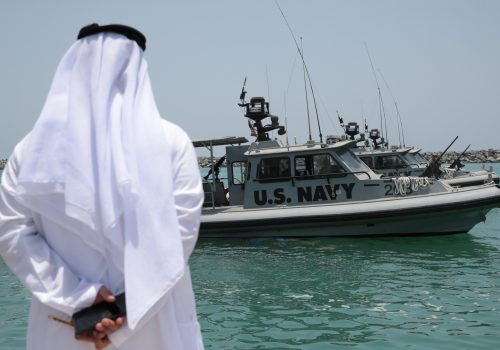In Yemen and elsewhere, manageable local issues are driving an unmanageable regional crisis
Unprecedented and alarming breaches of security taboos are jolting the Middle East week after week. The US-led missile strikes on Houthi positions in northern Yemen on January 11 and January 12 were the latest in a series of escalating armed actions in the Middle East, which have been generated by the ongoing war between Israel and militant groups in Gaza. The strikes followed weeks of repeated warnings by the United States to the Iran-backed Houthis over the latter’s continued harassment of commercial vessels traversing the Red Sea.
The United States put teeth into its warnings by deploying naval vessels and assembling a coalition of mostly European nations to stand against the attacks. But the Houthis were undeterred. On January 9, the group launched what US National Security Council spokesman John Kirby described the next day as “a complex attack of one-way attack drones, anti-ship cruise missiles, and an anti-ship ballistic missile” toward US ships in the Red Sea.
The US-led barrage launched late on January 11 and a follow-up the next day struck positions in the capital, Sana’a, the port city of Hodeidah, and other cities, according to the Houthi’s al-Masirah news platform. The barrage hit radars, missile, and drone launch sites as well as weapons storage areas, said US Defense Secretary Lloyd Austin in a statement. The US and its allies studiously avoided targets that could create casualties—an attempt to prevent a further escalation while deterring the Houthis from their regular attacks.
The Houthis will remain defiant. Before the attacks, US Secretary of State Antony Blinken traveled around the region warning of consequences for Houthi leader Abdul-Malik Badr al-Din al-Houthi, who vowed that he would not halt its attacks on ships it believed were linked to Israel, regardless of what the United States and the United Kingdom did. Hours after the barrage, the Sana’a government’s Deputy Foreign Minister, Hussein Al-Ezzi, warned on social media that “America and Britain must prepare to pay a heavy price and bear all the dire consequences of this blatant aggression.”
Such bluster is unsurprising. After an initial face-saving response that will likely involve the Houthis’ arsenal of drones and Iran-supplied rockets, the US-led demonstration of firepower may prompt the Houthis to ease up their attacks for a period—a predictable pattern of behavior by Iran-backed groups and allies, including Lebanese Hezbollah, Iraqi Shia militias, the Bashar al-Assad regime in Syria, and even Tehran itself. Despite the dire headlines and reports on the Houthis’ al-Masirah channel, the elders within the Houthi camp, as well as the group’s backers in Iran and Lebanon, will likely detect a US reluctance to get more militarily involved in the Middle East’s various conflicts than it absolutely must.
Sign up for the This week in the Mideast newsletter
But the airstrikes were relatively unprecedented. The United States has launched drone strikes against al-Qaeda affiliates in Yemen and struck Houthi coastal and marine forces in the past. However, the January 11-12 attacks amounted to only the second American action against a non-jihadi group on Yemeni soil and the first to hit Sana’a. Though it was measured, it amounted to yet another escalation in the Middle East since Hamas’ October 7 attack on southern Israel and the subsequent ongoing Israeli military campaign in Gaza. The attack will almost certainly stoke passions regardless of how political leaders interpret them. The Houthis called for thousands of protesters to gather for politically charged Friday prayers.
There have been other novel events in recent weeks. On New Year’s Day, Iran’s Alvand-class frigate, the Alborz, entered the Red Sea. Though upgraded several times over the decade, the British-made warship is fifty-five years old and was delivered to the late Shah of Iran. It has made previous sojourns to the Red Sea; doing so on one occasion to protect Iran’s ships from the scourge of piracy. It is no match for the United States and allied forces that have been deployed in the waters off Yemen. Yet the arrival raised alarm bells. While Iranians have surreptitiously provided the Houthis with weapons, training, and support, the voyage marked a rare instance when Iran overtly dispatched military hardware to the waters off Yemen.
Over the last three months, precedent-setting armed escalation has taken place in trouble spots all over the Middle East. It began with Hamas’ shocking attacks on southern Israel on October 7, 2023, and continued with the unceasing length of the Israeli response. The Houthis have attacked civilian ships in the past, but they have done so over the last few weeks with a particular intensity.
Steering the region toward a more stable path may be beyond the power of any world power. However, the White House and its allies could limit or slow the deterioration by addressing each crisis separately.
Though the Joe Biden White House has toned down some of the hyperbole of its predecessors, it continues to operate in the Middle East with a Cold War mentality; it still attempts to rally partners against perceived enemies while clinging to the notion that the region has good and bad guys. Instead, the US and its partners could work to resolve more manageable problems that contribute to the region’s toxicity.
Both Hamas’ attack and Israel’s lengthy offensive are rooted in intra-Palestinian and intra-Israeli politics and rivalries. Iraqi militias’ abuses and transgressions, including their attacks on US troops in Syria, are aimed at weakening the central government in the eyes of Iraqis and the world. Even Iran’s decision to avoid direct involvement in the Gaza conflict may be rooted in domestic ambivalence toward the Palestinian cause.
Local conditions—rather than broader geopolitical objectives—may also drive the Houthis’ aggression. Iran, Syria, Hezbollah, Iraq’s Shia militias, the Houthis, Hamas, and Palestinian Islamic Jihad make up a so-called “Resistance Axis.” Tehran may have influence over Houthi leadership as it offers guidance, material, and logistical support, and there is evidence that Yemeni fighters have taken part in the same military training programs Iran has provided to Iraqi, Syrian, Afghan, and Lebanese militiamen.
However, there is little evidence that Iran has much direct operational control over the increasingly sprawling network of coalitions and alliances that make up the Sana’a government. Neither Iran nor Hezbollah, for example, are systematically targeting foreign vessels believed to be traveling to or from Israel.
While there is a sense of triumphalism that the ten-year-old rebel movement has now surpassed all expectations for its survival, it may not be a coincidence that the attacks and the Houthis’ escalating aggression are coming on the heels of the ceasefire with Saudi Arabia. Increased military capacity may contribute to the Houthis’ action. However, sustaining a sense of crisis and unceasing war also plays a role in maintaining domestic control. As long as the Saudi-led war effort against the Houthis raged, the group could keep a siege mentality and paper over its incompetence, misgovernance, corruption, and repression. With the Saudi-led war all but over, the Houthis may be feeling vulnerable. The Gaza war and the Houthis’ direct involvement perpetuate the crisis atmosphere.
Striking targets engaged in attacks on foreign-flagged vessels is legitimate. Nevertheless, the United States and international response should remain otherwise measured so as not to play into the hands of the Houthis. Instead, the US would do well to point out the Houthi’s failures and press them on basic matters, with a focus on asking tough questions about when the group will begin the arduous work of capitalizing on the Saudi ceasefire, such as restarting the country’s economy and rebuilding from more than a decade of war and one of modern history’s worst humanitarian crises. Such an approach could put the Houthis on the defensive while showing solidarity with a Yemeni public chafing under Houthi control, perhaps pressing the group to address basic local needs instead of grandstanding over Israel.
No power in the world seems capable of cooling down a Middle East aflame. Nevertheless, if the United States tailors its messaging and actions around each crisis on its own terms, and takes local and regional dynamics seriously, it may be able to place modest limits on the escalatory actions of the various players in the Middle East.
Borzou Daragahi is a journalist who has covered the Middle East, North Africa, and Europe for US and UK news outlets since 2002. He is also a nonresident fellow with the Atlantic Council’s Middle East Security Initiative. Follow him on X: @borzou.
Further reading
Fri, Jan 12, 2024
Six big questions about US-led strikes against the Houthis, answered
MENASource By Kirsten Fontenrose
Ahead of authorizing the strikes, Biden had to carefully consider arguments for and against conducting strikes to limit the Houthis’ capacity to continue waging war on international shipping.
Fri, Jan 7, 2022
I’m the former foreign minister of Yemen. My country is starving and needs the international community’s help.
MENASource By Khaled H. Alyemany
The situation in Yemen cannot be permitted to continue on its current trajectory. The international community must act immediately to remedy its issues and change the country’s course from disaster to diplomacy.
Thu, Jun 18, 2020
Gulf states should defend their sea lanes: Here’s how
Blog Post By Richard LeBaron, John W. Miller
The United States should play more of a supporting role with the Gulf states themselves providing more leadership and most, if not all of the forces.
Image: FILE PHOTO: Houthi leader Abdul-Malik al-Houthi delivers a speech through a TV screen during a rally to mark the birthday of the Prophet Muhammad, in Sanaa, Yemen September 27, 2023. REUTERS/Khaled Abdullah/File Photo


